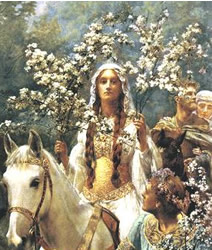 |
Queen
Guinevere A-Maying John Collier, 1900 |
Modern Pagans perceive the sacred at work in the whole of existence. Physically manifested in the round of the seasons and cycles of creativity, one way of picturing this symbolically is in a changing relationship between Goddess and God.
Beltane—a Celtic word meaning ‘fires of Bel’ or ‘brilliant fire’—is the festival heralding the arrival of summer, a time when light is indeed on the increase. This is the moment in the great round when the god born at the winter solstice (Yule) has achieved the strength and maturity to mate with the goddess. It is the most overtly sexual of the Pagan festivals, yet sex is rarely an element of the actual ritual, rather appearing in symbolic form such as the maypole dance or leaping over the fire.
Historically Celtic religious observances were tied to the needs of the community. In order to ensure bountiful herds, farm animals would be led between fires in a Beltane ritual aimed towards purification and increasing fertility. Symbolic marriages of the god and goddess—for example, in the form of King and Queen of the May—were often mirrored in actual human courtship: it used to be said that children conceived at Beltane* were gifted by the gods.
As one of the four great fire festivals Beltane is still an occasion for bonfires. Each year in Edinburgh thousands of people gather together and proceed beneath an arch of fire** to the top of Carlton Hill. Led by a couple dressed as the May Queen and the Green Man,*** the participants dance and the couple are ritually married, thus symbolically ensuring fertility for all.
*Known
as Merry-Be-Gots.
**Representing the gateway between the earthly world
and the spirit realm.
***The May Queen’s consort is known by many names, occasionally
appearing as Jack-in-the-Green, Robin Hood or Puck, the spirit of the
wood.